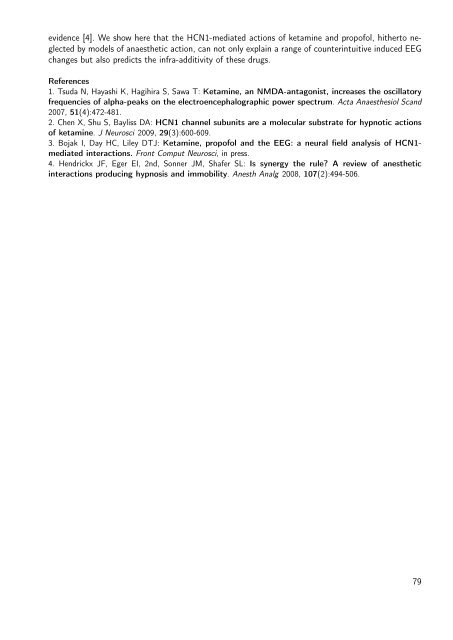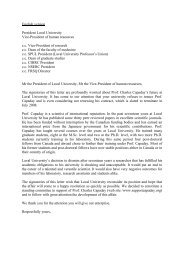y the field model, strongly influences the information processing that occurs within its subnetworks. References 1. Kerr CC, Neymotin SA, Chadderdon GL, Fietkiewicz CT, Francis JT, Lytton WW: Electrostimulation as a prosthesis for repair <strong>of</strong> information flow in a computer model <strong>of</strong> neocortex. IEEE Trans Neural Syst Rehabil Eng 2012, 20:153-160. 2. Van Albada SJ, Robinson PA: Mean-field modeling <strong>of</strong> the basal ganglia-thalamocortical system. I. Firing rates in healthy <strong>and</strong> parkinsonian states. J Theor Biol 2009, 257:642-63. 3. Van Albada SJ, Gray RT, Drysdale PM, Robinson PA: Mean-field modeling <strong>of</strong> the basal gangliathalamocortical system. II. Dynamics <strong>of</strong> parkinsonian oscillations. J Theor Biol 2009, 257:664-88. O22 HCN1-mediated interactions <strong>of</strong> ketamine <strong>and</strong> prop<strong>of</strong>ol in a mean field model <strong>of</strong> the EEG Ingo Bojak 1,2,3⋆ , Harry Day 2 , <strong>and</strong> David Liley 4,5 1 School <strong>of</strong> Systems Engineering, University <strong>of</strong> Reading, Whiteknights, Berkshire, RG6 6AY, UK 2 School <strong>of</strong> Psychology (CNCR), University <strong>of</strong> Birmingham, Edgbaston, Birmingham B15 2TT, UK 3 Donders Institute, Radboud University Nijmegen (Medical Centre), 6500 HB Nijmegen, The Netherl<strong>and</strong>s 4 Brain & Psychological Sciences Research Centre, Swinburne Uni. <strong>of</strong> Tech., Hawthorn, Victoria 3122, Australia 5 Cortical Dynamics Ltd., Suite 4, 462 Burwood Road, Hawthorn, Victoria 3122, Australia Figure 1. Predicted shift <strong>of</strong> the alpha peak frequency <strong>of</strong> ten parameter sets during four phases <strong>of</strong> linear change to the normalized ketamine (K) <strong>and</strong> prop<strong>of</strong>ol (P) concentrations, respectively. Ketamine <strong>and</strong> prop<strong>of</strong>ol, two popular anesthetic agents, are generally believed to operate via disparate primary mechanisms: ketamine through NMDA antagonism <strong>and</strong> prop<strong>of</strong>ol through the potentiation <strong>of</strong> GABA A - gated receptor currents. However, surprisingly the effect <strong>of</strong> ketamine on the EEG is markedly altered in the presence <strong>of</strong> prop<strong>of</strong>ol. Specifically, while ketamine alone results in a downshift <strong>of</strong> the peak frequency <strong>of</strong> the alpha rhythm, <strong>and</strong> prop<strong>of</strong>ol keeps it roughly constant - when administered together, they increase the alpha peak frequency [1]. Recently it has been found that both ketamine <strong>and</strong> prop<strong>of</strong>ol inhibit the hyperpolarization-activated cyclic nucleotide-gated potassium channel form 1 (HCN1) subunits, which induces neuronal membrane hyperpolarization [2]. Furthermore, HCN1 knockout mice are significantly less susceptible to hypnosis with these agents; but equally affected by HCN1-neutral etomidate [2]. We show here [3] that an established mean field model <strong>of</strong> electrocortical activity can predict the EEG changes induced by combining ketamine <strong>and</strong> prop<strong>of</strong>ol by taking into account merely the HCN1-mediated hyperpolarisations, but neglecting their supposed main mechanisms <strong>of</strong> action (NMDA <strong>and</strong> GABA A , respectively). See Figure 1. Our results suggest that ketamine <strong>and</strong> prop<strong>of</strong>ol are infra-additive in their HCN1-mediated actions. This is consistent with independent experimental 78
evidence [4]. We show here that the HCN1-mediated actions <strong>of</strong> ketamine <strong>and</strong> prop<strong>of</strong>ol, hitherto neglected by models <strong>of</strong> anaesthetic action, can not only explain a range <strong>of</strong> counterintuitive induced EEG changes but also predicts the infra-additivity <strong>of</strong> these drugs. References 1. Tsuda N, Hayashi K, Hagihira S, Sawa T: Ketamine, an NMDA-antagonist, increases the oscillatory frequencies <strong>of</strong> alpha-peaks on the electroencephalographic power spectrum. Acta Anaesthesiol Sc<strong>and</strong> 2007, 51(4):472-481. 2. Chen X, Shu S, Bayliss DA: HCN1 channel subunits are a molecular substrate for hypnotic actions <strong>of</strong> ketamine. J Neurosci 2009, 29(3):600-609. 3. Bojak I, Day HC, Liley DTJ: Ketamine, prop<strong>of</strong>ol <strong>and</strong> the EEG: a neural field analysis <strong>of</strong> HCN1- mediated interactions. Front Comput Neurosci, in press. 4. Hendrickx JF, Eger EI, 2nd, Sonner JM, Shafer SL: Is synergy the rule A review <strong>of</strong> anesthetic interactions producing hypnosis <strong>and</strong> immobility. Anesth Analg 2008, 107(2):494-506. 79
- Page 3:
Contents Overview 5 OCNS - The Orga
- Page 7 and 8:
Organization for Computational Neur
- Page 9:
CNS*2013 Sponsors Brain Corporation
- Page 13 and 14:
General Info At the Meeting Venue T
- Page 15 and 16:
Local Information Since a list of a
- Page 17 and 18:
• You have a nice 360°-view over
- Page 19:
Gala Diner The gala diner will take
- Page 23 and 24:
Tutorials T1 Neural-mass and neural
- Page 25 and 26:
Main Meeting 25
- Page 27 and 28: Oral session II: Visual system 14:0
- Page 29 and 30: Tuesday July 16 9:00 - 9:10 Announc
- Page 31 and 32: Workshops Note: W21 will be held Th
- Page 33 and 34: W10 New approaches to spike train a
- Page 35: Abstracts
- Page 38 and 39: makes generalised seizures more lik
- Page 40 and 41: • a scheme for biophysically deta
- Page 42 and 43: • Pecevski et al. (2011), Probabi
- Page 44 and 45: [5] Goodman (2010), Code generation
- Page 46 and 47: eview key theoretical results and p
- Page 48 and 49: Simon Laughlin Department of Zoolog
- Page 51 and 52: Contributed Talks F1 Consistency re
- Page 53 and 54: activation phase locks in the senso
- Page 55 and 56: tigated whether eCBs could also pro
- Page 57 and 58: 2. Kobayashi R, Shinomoto S, Lansky
- Page 59 and 60: O5 We now know what fly photorecept
- Page 61 and 62: (B.Stem). The retina covers 10 by 1
- Page 63 and 64: internally generated propagating wa
- Page 65 and 66: We examine spike-count correlations
- Page 67 and 68: Our results predict that thermosens
- Page 69 and 70: corresponding experimental observat
- Page 71 and 72: Figure 1: Properties of the model (
- Page 73 and 74: goal-directed movements. Here, seve
- Page 75 and 76: escence. In the low connectivity re
- Page 77: O21 Multiscale modeling of cortical
- Page 82 and 83: • How can one distinguish and stu
- Page 84 and 85: network model in realtime W4 Method
- Page 86 and 87: Rita Almeida, Karolinska Institute;
- Page 88 and 89: greater detail. For example, dendri
- Page 90 and 91: effective processing of task-relate
- Page 92 and 93: W14 Modeling general anesthesia: fr
- Page 94 and 95: Arvind Kumar, Freiburg: Basal gangl
- Page 96 and 97: Morten Kringelbach, Oxford Maxime G
- Page 99 and 100: Posters
- Page 101 and 102: Posters Sunday Posters Posters P1 -
- Page 103 and 104: P11 The role of inhibition in the g
- Page 105 and 106: P25 P26 P27 P28 Estimating the frac
- Page 107 and 108: P37 Zero-Lag Synchronization in Cor
- Page 109 and 110: P48 Requirements for the Robust Ope
- Page 111 and 112: P59 A maximum likelihood estimator
- Page 113 and 114: P72 P73 The behavior of the electri
- Page 115 and 116: P84 Multistability in large scale m
- Page 117 and 118: P96 A biophysical model of cerebell
- Page 119 and 120: P105 Estimating the transfer functi
- Page 121 and 122: P117 P118 Neuronal Coding in the Ro
- Page 123 and 124: P128 P129 P130 P131 P132 P133 P134
- Page 125 and 126: P141 Visually guided behavior in fr
- Page 127 and 128: P151 P152 P153 P154 Estimation of n
- Page 129 and 130:
P163 From laptops to supercomputers
- Page 131 and 132:
P173 Single cell neuro-sensory dyna
- Page 133 and 134:
P186 Latency and rate coding in a s
- Page 135 and 136:
P200 On the influence of inhibitory
- Page 137 and 138:
P213 Estimating synaptic connection
- Page 139 and 140:
P228 Controlling the Go / No-Go dec
- Page 141 and 142:
P240 P241 P242 P243 P244 P245 P246
- Page 143 and 144:
P254 Motion control of thumb and in
- Page 145 and 146:
P267 Non-instantaneous synaptic tra
- Page 147 and 148:
P280 P281 Trial by trial decoding o
- Page 149 and 150:
149
- Page 151 and 152:
P297 A numerical renormalisation gr
- Page 153 and 154:
P309 Detection of neuronal signatur
- Page 155 and 156:
P321 Long-Term Potentiation Through
- Page 157 and 158:
P334 Sparse coding model captures V
- Page 159 and 160:
P347 Influence of biophysical prope
- Page 161 and 162:
P360 Plasticity of Network Dynamics
- Page 163 and 164:
P373 The implications of evolutiona
- Page 165 and 166:
P386 Attractor dynamics in local ne
- Page 167 and 168:
P398 Why are all phase resetting cu
- Page 169 and 170:
P410 Prefrontal cortical modulation
- Page 171 and 172:
P422 Olfactory bulb network dynamic
- Page 173 and 174:
P435 Center-Surround Interactions i
- Page 175 and 176:
Appendix
- Page 177 and 178:
Notes 177
- Page 179 and 180:
179
- Page 181 and 182:
181
- Page 183 and 184:
183
- Page 185 and 186:
Page Index A Aazhang, Behnaam . . .
- Page 187 and 188:
Chavane, Frederic . . . . . . . . .
- Page 189 and 190:
Gerhard, Felipe . . . . . . . . . .
- Page 191 and 192:
Kömek, Kübra. . . . . . . . . . .
- Page 193 and 194:
Muresan, Raul Cristian. . . . . . .
- Page 195 and 196:
Rotstein, Horacio G. . . . . . . .
- Page 197 and 198:
V Valderrama, Mario . . . . . . . .
- Page 199 and 200:
Contributions Index A Aazhang, Behn
- Page 201 and 202:
Chartier, Josh . . . . . . . . . .
- Page 203 and 204:
Gekas, Nikos . . . . . . . . . . .
- Page 205 and 206:
Knösche, Thomas . . . . . . . . .
- Page 207 and 208:
Mosqueiro, Thiago . . . . . . . . .
- Page 209 and 210:
Ronacher, Bernhard . . . . . . . .
- Page 211 and 212:
Tsigankov, Dmitry. . . . . . . . .



